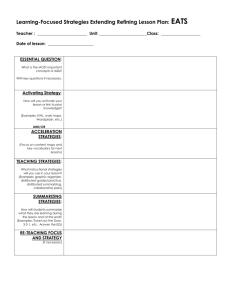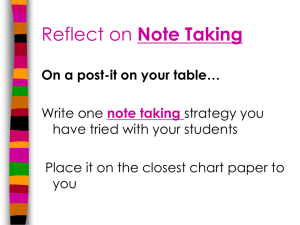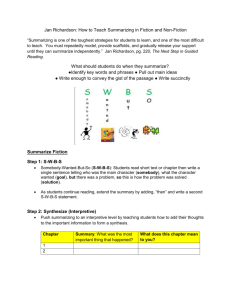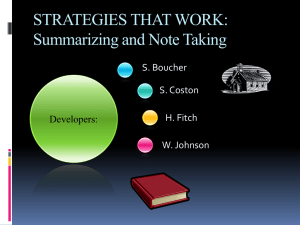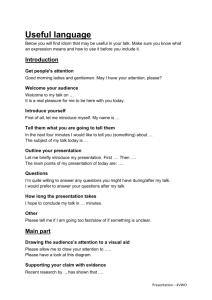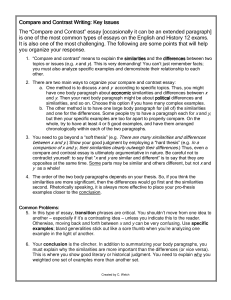Summarizing and Notetaking Art 6
advertisement
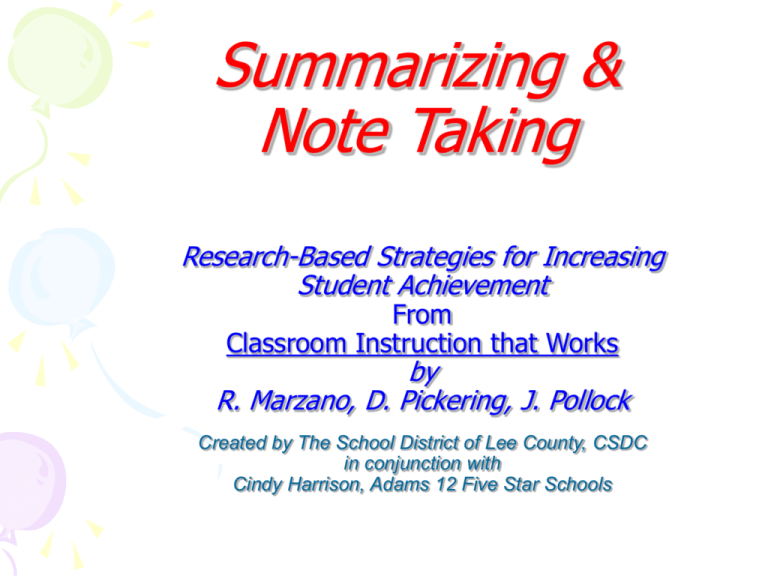
Summarizing & Note Taking Research-Based Strategies for Increasing Student Achievement From Classroom Instruction that Works by R. Marzano, D. Pickering, J. Pollock Created by The School District of Lee County, CSDC in conjunction with Cindy Harrison, Adams 12 Five Star Schools Participant Outcomes Participants will: • Understand the purpose and importance of summarizing and note taking • Identify ways to implement summarizing and note taking in the classroom • Review examples of summarizing and note taking activities Average Effect Category Identifying similarities and differences Percentile Size (ES) Gain 1.61 45 No. of ESs 31 Summarizing and note taking 1.00 34 179 Reinforcing effort and providing recognition 0.80 29 21 Homework and practice 0.77 28 134 Nonlinguistic representations 0.75 27 246 Cooperative learning 0.73 27 122 Setting objectives and providing feedback 0.61 23 408 Generating and testing hypotheses 0.61 23 63 Questions, cues and advance organizers 0.59 22 1,251 Summarizing Discussion question: How do you currently teach students in your classroom to summarize information to enhance student learning? Research and Theory about Summarizing Generalizations based on research: 1. Students must delete, substitute, and keep some information when summarizing. 2. Deep analysis is needed in order to do #1. 3. Must be aware of explicit structure of information. Research and Theory about Summarizing Generalization #1: Students must delete, substitute, and keep some information when summarizing. • • • • Condensing information Looking for patterns Distilling (extracting) and synthesizing information Modeling by teachers Research and Theory about Summarizing Generalization #2: To effectively delete, substitute, and keep information, students must analyze the information at a fairly deep level. • • Seems simple but requires analyzing content Students need practice to be good at analyzing information Generalization #3: Must be aware of explicit structure of information. • Most artists present information with an explicit structure or pattern. The more students understand these structures, the better they are able to summarize information. Recommendations for Classroom Practice on Summarizing a. Teach the “Rule-Based” Strategy – Follows a set of rules that produce a summary Recommendations for Classroom Practice on Summarizing MODEL FOR SUMMARIZING Steps in Rule-Based Summarizing for Steps in Rule-Based Summarizing for Younger Students Older Students 1. Take out material that is not 1. Delete trivial material that is important to understanding. unnecessary to understanding. 2. Take out words that repeat 2. Delete redundant material. information. 3. Substitute subordinate terms for 3. Replace a list of things with a word more specific terms (e.g., use fish that describes the things in the list for rainbow trout, salmon, and (e.g., use trees for elm, oak, and halibut.) maple). 4. Select a topic sentence of invent 4. Find a topic sentence. If you one if it is missing. cannot find a topic sentence, make one up. “Rule Based Strategy” for Summarizing Applied to Reading Art Content • Delete less important details • Delete redundant information • Substitute general for specific • Select or create topic sentence “Rule Based Strategy” for Summarizing Applied to Sketching •Delete less important details •begin with contours and shapes •Delete redundant info •Omit repeated details •Substitute general for specific •Basic lines and values •Select or create topic sentence •Emphasize subject Recommendations for Classroom Practice on Summarizing b. Use Summary Frames – Choose frame to match information type – 6 different types of frames • • • • • • Narrative Topic-restriction-illustration Definition Argumentation Problem/solution Conversation Narrative Frame A “Narrative Frame” is found in fiction and in Narrative Art. It contains: • • • • • • • Characters – Who Setting – Where Initiating event – Starts action Internal response – Reaction to event Goal – What they decide to do Consequence – How they meet the goal Resolution – How it turns out Narrative Frame Art Example Steps of Narrative Frame 1. Characters – who are they? 2. Setting – where does it take place? 3. Initiating event – what happened at the beginning? 4. Internal response – What happens as a reaction to the event? 5. Goal – What do the characters decide to do? 6. Consequence – What happens because of their decision? 7. Resolution –How does it end? Read the myth of Daphne and Apollo. Use the steps of Narrative Frame to interpret and analyze this sculpture by Bernini. Topic – Restriction – Illustration TRI Frame A “Topic – Restriction – Illustration” Frame is found in expository materials and includes: • Topic – General statement • Restriction – Limits the information • Illustrations – Exemplifies the topic TRI Frame Art Example Topic: What is the meaning of “Post Impressionism”? Post Impressionism is the movement after Impressionism which explored elements of art, composition and mood. Restriction: How does it differ from other artistic periods? Elements of Art (color texture) were emphasized, and artists were concerned with more than just the effects of light. Illustrations: Cezanne, Seurat, van Gogh Definition Frame A “Definition Frame” describes a particular concept and related concepts: • Term- Word to be defined • Set – General category it is in • Gross Characteristics – How it differs • Minute – What are sub classes? Definition Frame Art Example Use “Definition Frame” to describe the concept of Balance: Term- Balance Set – Principle of Design Gross Characteristics – Visual weight and arrangement of elements. Minute – Symmetry, Asymmetry and Radial Argumentation Frame An “Argumentation Frame” contains information to support a claim. • Evidence – What info leads to a claim? • Claim – Asserts that something is true • Support – Examples that support claim • Qualifiers - Restrictions Argumentation Frame Art Example •Evidence – Historically, artists have used their art as propaganda to persuade people toward a political perspective •Claim – Goya was a political artist •Support – Examples: The Third of May 1808, Saturn Devouring his Children, The Disasters of War etchings •Qualifiers – Other artists (Picasso, Daumier, Chicago) also created political art. The Problem/Solution Frame A “Problem/Solution Frame” identifies a problem and generates solutions. • What is the problem? • What is one solution? • What is another solution? • What is another solution? • Which is the best? Problem/Solution Frame Art Example What is the problem? How to draw a portrait to sell What is one solution? Realism What is another solution? Abstract What is another solution? Cubism Which will I choose and why? Realism, because it is more likely to sell Conversation Frame A “Conversation Frame” is a verbal interchange between two or more people, • Greeting – Conversation opener • Inquiry – General information • Discussion – Elaboration (Assertions, Requests, Promises. Demands, Threats, Congratulations) • Conclusion – Conversation ending Conversation Frame Art Example •Greeting – Conversation opener •Inquiry – General information •Discussion – Elaboration (Assertions, Requests, Promises. Demands, Threats, Congratulations) •Conclusion – Conversation ending Recommendations for Classroom Practice on Summarizing c. Teach Students Reciprocal Teaching – 4 step process 1. Summarizing 2. Questioning 3. Clarifying 4. Predicting Reciprocal Teaching • Summarizing - What happened? • Questions - What did you like/dislike and why? What questions did you have when you read? • Clarifying - What words did you not understand? • Predicting - What do you think will happen next? Note Taking Discussion statement: It is appropriate for the teacher to provide students with a complete set of notes on a topic. Do you… Strongly Agree Agree Disagree Strongly Disagree Research and Theory about Note Taking Generalizations based on research: 1. Verbatim note taking is least effective. 2. Should be a work in progress. 3. Should be used as study guides for tests. 4. The more notes taken, the better. Research and Theory about Note Taking Generalization #1: Verbatim note taking is least effective. • • Not engaged in synthesis Only recording, not analyzing Generalization #2: Should be a work in progress. • • • Continually add to notes Revise notes Time to review notes Research and Theory about Note Taking Generalization #3: Should be used as study guides for tests. • If well done, powerful study guide Generalization #4: The more notes taken, the better. • Strong correlation between amount of notes and achievement on exams Recommendations for Classroom Practice on Note Taking a. Give Teacher-Prepared Notes Sketchbook Assignment – Use Emphasis in a Drawing Teacher Prepared Notes Graphic Questions i. The Basics - Emphasis A. Makes something stand out B. Creates a focal point (draw illustration here) How can I use Emphasis to make my composition more visually interesting? ii. Characteristics A. Contrast B. Focal Point C. Dominance (draw illustration here) How can I use the Elements of Art to create Emphasis? Recommendations for Classroom Practice on Note Taking b. Teach Multiple Formats (Students select which format works for them) Informal Outline (verbal organization) Web (visual organization) Combination Notes (both) Recommendations for Classroom Practice on Note Taking c. Use Combination Notes Uses 3 parts: 1. Informal outlining 2. Graphic representation 3. Summary Combination Notes Regular notes Symbol, picture or graphic Summary Combination Notes Notes (Verbal) Graphic (Visual) Shapes and Forms Shape is 2-dimensional, flat, SHAPES lacks volume, describes area, length and width, may be organic or geometric. Form is 3-dimensional, has volume, occupies an FORMS area, has length, Width and Depth, May be Organic or Geometric. An illusion of depth is created In 2D art. Summary: Shape and Form are both enclosed spaces, but Shape is flat and Form has volume. Using a whip What have you learned about summarizing and note taking? What thoughts, questions, challenges, or ideas do you have?
